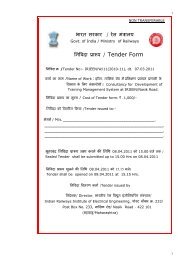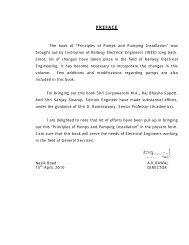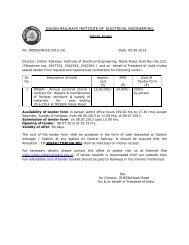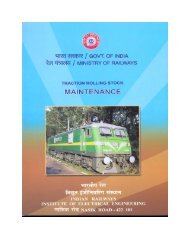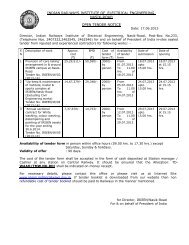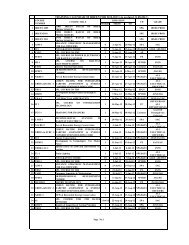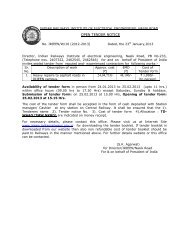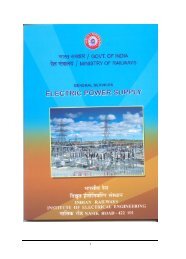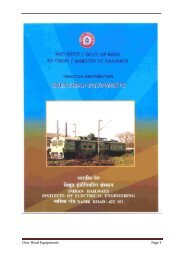remote control equipment - Indian Railways Institute of Electrical ...
remote control equipment - Indian Railways Institute of Electrical ...
remote control equipment - Indian Railways Institute of Electrical ...
You also want an ePaper? Increase the reach of your titles
YUMPU automatically turns print PDFs into web optimized ePapers that Google loves.
• Characteristics <strong>of</strong> the locomotive and speed etc.<br />
• Allowable permissible voltage drop at the farthest end.<br />
• Strength <strong>of</strong> the system to permit the voltage and current unbalance<br />
caused by the traction single phase loads.<br />
• Suitability <strong>of</strong> standard <strong>equipment</strong>s.<br />
• The load is within the standard ratings <strong>of</strong> the transformer and other<br />
<strong>equipment</strong> under normal and extended feed conditions.<br />
• Availability <strong>of</strong> reasonably good levelled land as near to Rly track as<br />
possible.<br />
• Location should be away from the dumping yards.<br />
• Location <strong>of</strong> sub-station should not be less than 3 km from the airport.<br />
• Provision <strong>of</strong> siding track for loading and unloading <strong>of</strong> heavy <strong>equipment</strong>s.<br />
• Location should be close to main Rly. station where inspection staff can<br />
reach the spot in the shortest time<br />
4.0.4 On an average the spacing between the successive sub-station as adopted in<br />
earlier electrification schemes was about 50 to 80 km, but with the interlocution <strong>of</strong><br />
heavy haul trains and increased passenger and goods traffic the spacing has been<br />
reduced to 40 to 60 km. only. On high density routes it may reduce further by<br />
converting existing SP into TSS and SSP into SP.<br />
4.1 TRACTION POWER SUPPLY SYSTEM<br />
4.1.1 Before going into details <strong>of</strong> design aspects <strong>of</strong> various substation<br />
<strong>equipment</strong>s, we may briefly discuss the power supply system adopted for feeding<br />
the traction substations.<br />
4.1.2 <strong>Indian</strong> Rlys. purchase electric power from various state electricity boards<br />
and as well as from other electric utilities through their regional grids at different<br />
voltage, normally 220/132/110/66 kV. The incoming supply is stepped down to<br />
25 kv. a.c. with the help <strong>of</strong> step down transformer. The primary winding <strong>of</strong> the<br />
transformer is connected across two phases <strong>of</strong> the three phase effectively earthed<br />
system and one terminal <strong>of</strong> the 25 kV. secondary winding is connected to the<br />
overhead <strong>equipment</strong> (OHE) and other terminal <strong>of</strong> the 25 kV. secondary winding is<br />
solidly earthed and connected to the running rails. The load current flows through<br />
the OHE to the locomotive and return through the rails and earth to the traction<br />
sub-station.<br />
The substations are provided as close to the railway traction as possible at<br />
intervals varying from 40 to 60 km depending upon the traffic density and track<br />
conditions. In the initial stages <strong>of</strong> the AC electrification schemes, traction<br />
74




